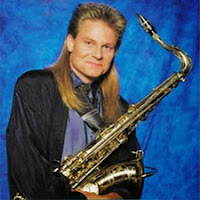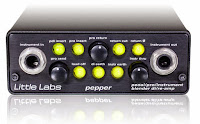The song that turned Dire Straits into international superstars came in the form of the giant hit "Money For Nothing" from their 1985 album Brothers In Arms album. The song hit MTV at it's peak in 1987 and seemed to play every hour.
The song was distinctive in that it has an unusual guitar sound, especially for guitarist Mark Knopfler, who usually plays through a Strat. In this case the sound comes from a Les Paul through a Laney amplifier, but the real secret is the wah-wah set to half-way to give it that mid-rangey sound.
Here's what to listen for.
1. The song begins with the the guitar covered in a short reverb, but then goes dry for the rest of the song.
2. The guitar is in stereo until the chorus, at which point it's doubled and stays that way from that point on.
3. If you're used to hearing the edited radio version, this is the extended album version, so it goes much longer and the guitar parts are a lot looser as the song gets towards the end.
Help Support This Blog
Friday, May 29, 2015
Dire Straits "Money For Nothing" Isolated Guitar Track
Labels:
dire straits,
isolated guitar,
Mark Knopfler,
video,
wah-wah
Thursday, May 28, 2015
A Manley Labs Virtual Factory Tour
I think I posted an abbreviated video of the Manley Labs factory tour about a year ago, but here's the official version. It's a brilliant illustration of why Manley products are of the highest quality.
EveAnna Manley's attention to detail is unsurpassed and you can tell by this video. Manley gear is truly made-in-America, and you'll see how even the panel engraving, machining and transformer winding is done at the factory, which is very unique in these days of outsourcing.
There's one thing that's generally true in any industry and certain holds true here - excellent people = excellent gear!
EveAnna Manley's attention to detail is unsurpassed and you can tell by this video. Manley gear is truly made-in-America, and you'll see how even the panel engraving, machining and transformer winding is done at the factory, which is very unique in these days of outsourcing.
There's one thing that's generally true in any industry and certain holds true here - excellent people = excellent gear!
Labels:
EveAnna Manley,
factory tour,
Manley Labs,
video
Wednesday, May 27, 2015
4 Tips For A Great Headphone Mix
Most musicians perform better with a great mix and headphones that work perfectly. Here's an excerpt from The Recording Engineer's Handbook 3rd edition that provides 4 tips for getting those headphones session-ready.
"Perhaps the greatest detriment to a session running smoothly is the inability for players to hear themselves comfortably in the headphones. This is one of the reasons that veteran engineers spend so much time and attention to the cue mix and the phones themselves. In fact, a sure sign of an inexperienced engineer is treating the headphones and cue mix as an afterthought instead of spending as much time as required to make them sound great.
While it’s true that a veteran studio player can shrug off a bad or distorted phone mix and still deliver a fine performance, good “cans” makes a session go faster and easier, and takes a variable that can sometimes be the biggest detriment to a session out of the equation.
Companies like Behringer, Furman, PreSonus, Rolls and Aphex all make units that will work better and can be a lot cheaper than the traditional method of a large power amp and resistors."
"Perhaps the greatest detriment to a session running smoothly is the inability for players to hear themselves comfortably in the headphones. This is one of the reasons that veteran engineers spend so much time and attention to the cue mix and the phones themselves. In fact, a sure sign of an inexperienced engineer is treating the headphones and cue mix as an afterthought instead of spending as much time as required to make them sound great.
While it’s true that a veteran studio player can shrug off a bad or distorted phone mix and still deliver a fine performance, good “cans” makes a session go faster and easier, and takes a variable that can sometimes be the biggest detriment to a session out of the equation.
1. Long before the session begins, test every headphone to make sure there’s no distortion and they’re working correctly (test with actual music).
2. Make sure that there’s plenty of cable available so that the musicians can move around as needed. Use cable extenders as necessary.
3. Check to make sure that the cables are not intermittent (nothing stops a session as fast as a crackling phone).
4. Some engineers send the stereo monitor mix (the mix that you’re listening to in the control room) to the phones first, then add a little of the individual instruments as needed (“more me”). This is a lot easier than building up individual mixes, unless that’s what the musicians request.Where at one time each studio had to jury-rigged together their own headphone amp to power their cue mixes, these days its easy and fairly inexpensive to buy a dedicated headphone amplifier from any number of manufacturers that’s easy to set up and sounds great.
Companies like Behringer, Furman, PreSonus, Rolls and Aphex all make units that will work better and can be a lot cheaper than the traditional method of a large power amp and resistors."
To read additional excerpts from The Recording Engineer's Handbook and my other books, go to the excerpts section of bobbyowsinski.com.
Tuesday, May 26, 2015
Bob Clearmountain - Recording Drums With 4 Mics
Bob Clearmountain is one of the great recording and engineers of all time, mixing huge hits for The Rolling Stones, Bruce Springsteen, Paul McCartney, The Pretenders, and many more. He's also a part owner of Apogee Electronics, so he occasionally does some videos demonstrating their products.
Here's a great video where he shows the original Glyn Johns minimal miking technique as used on classic records by Led Zeppelin and The Who. Bob uses a 4 channel Apogee Quartet to record (hence the 4 microphones).
Matt Chamberlain is the drummer, and towards the end of the video he discusses the drum selection and tuning for a Jon Bonham sound. Very cool.
Here's a great video where he shows the original Glyn Johns minimal miking technique as used on classic records by Led Zeppelin and The Who. Bob uses a 4 channel Apogee Quartet to record (hence the 4 microphones).
Matt Chamberlain is the drummer, and towards the end of the video he discusses the drum selection and tuning for a Jon Bonham sound. Very cool.
Labels:
Apogee Electronics,
Apogee Quartet,
Bob Clearmountain,
glyn johns,
Jon Bonham,
Led Zeppelin,
Matt Chamberlain
Monday, May 25, 2015
Musician And Entrepreneur Scott Page On My Latest Inner Circle Podcast
I'm really pleased to have the the excellent musician and entrepreneur Scott Page on my podcast this week.
Not only has Scott played with such seminal bands as Pink Floyd, Supertramp and Toto, but he's also quite the entrepreneur as well, having started a number of tech companies, one which even went public!
How many rockers do you know that have rung the bell of the Stock Exchange? Well, Scott has.
On this episode's intro I'll also discuss controversial streaming site Grooveshark shutting down and rebirth, as well as the new study that outlines the 3 eras of pop music.
Remember that you can find the podcast at BobbyOInnerCircle.com, or either on iTunes or Stitcher.
Not only has Scott played with such seminal bands as Pink Floyd, Supertramp and Toto, but he's also quite the entrepreneur as well, having started a number of tech companies, one which even went public!
How many rockers do you know that have rung the bell of the Stock Exchange? Well, Scott has.
On this episode's intro I'll also discuss controversial streaming site Grooveshark shutting down and rebirth, as well as the new study that outlines the 3 eras of pop music.
New Music Gear Monday: Little Labs Pepper Effects Blender/DI
Little Labs is known for its unique problem solving boxes that more often than not tackle a problem that we might not be aware of initially but come to find out how important it is in our audio chain (a great example being the IBP phase tool). Now the company has introduced a new box that tackles the complex connection environment that electric musicians (especially guitar players) frequently find themselves in.
The Little Labs Pepper is a device with multiple uses. It can act as a blender for direct and effects signals, a direct box or a reamp box, but with a precision and adjustment range that most dedicated boxes don't have. It's made to be the hub that interfaces both hi-Z studio guitar pedals and low-Z studio effects, at both mic and line levels, all at once.
Pepper incorporates a high-quality analog signal path with UTC-style output transformers for mic and instrument level, along with a balanced transformer-less line level out. It also has both pedal and "Pro" hard bypass that can be controlled with a footpedal, and adjustable instrument input load impedance, as well as a "Load-Off" switch just for piezo pickups.
The unit is powered by a heavy duty external power supply and is Mu Metal shielded for quiet performance in both live and studio environments.
The Little Labs Pepper isn't cheap at around $650 street price, but it does what few other devices can do. Check out the video below for a more thorough explanation.
The Little Labs Pepper is a device with multiple uses. It can act as a blender for direct and effects signals, a direct box or a reamp box, but with a precision and adjustment range that most dedicated boxes don't have. It's made to be the hub that interfaces both hi-Z studio guitar pedals and low-Z studio effects, at both mic and line levels, all at once.
Pepper incorporates a high-quality analog signal path with UTC-style output transformers for mic and instrument level, along with a balanced transformer-less line level out. It also has both pedal and "Pro" hard bypass that can be controlled with a footpedal, and adjustable instrument input load impedance, as well as a "Load-Off" switch just for piezo pickups.
The unit is powered by a heavy duty external power supply and is Mu Metal shielded for quiet performance in both live and studio environments.
The Little Labs Pepper isn't cheap at around $650 street price, but it does what few other devices can do. Check out the video below for a more thorough explanation.
Labels:
DI,
direct box,
direct injection,
IBP phase tool,
Little Labs Pepper,
reamping
Subscribe to:
Comments (Atom)






